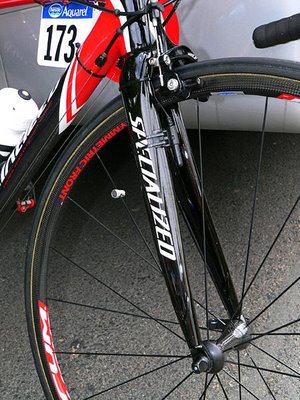By now pretty much everyone whether or not they’re a cyclist has heard that Floyd Landis has tested positive for too high a level of testosterone. They actually test for the ratio of testosterone to epitestosterone. Normally it is about 1 to 1. Recently the ratio for a positive test was lowered from 6:1 to 4:1.
Only the A sample has been tested and Landis has said he will ask for the B sample to also be tested. He says he “can’t be hopeful” about the B test. In the Tour de France they automatically test the stage winner and the yellow jersey wearer after each stage so he would have been tested a couple days before. I wonder if he was close to the limit then. Several riders who have returned test results with high testosterone have been able to prove they have naturally high levels of testosterone.
In an article on BBC Sport, Landis says that maybe the injections of cortisone he’s been getting for his hip may have had an effect. Normally cortisone is banned but he has an exemption because of his bad hip. He also revealed that he’s been on thyroid medication for about a year.
Reached by the AP, his mother Arlene Landis said she wouldn’t blame her son for taking medication to ease the pain of his hip.
“If it’s something worse than that, then he doesn’t deserve to win. I didn’t talk to him since that hit the fan, but I’m keeping things even keel until I know what the facts are. I know that this is a temptation to every rider but I’m not going to jump to conclusions… It disappoints me.”
I certainly hope he can be cleared but that will take time. I do have a problem with the fact that it was released yesterday that a rider had tested positive during the Tour. That caused speculation that it was Landis because he didn’t show up to 2 criteriums he was scheduled to be at. I don’t think anything should be released until after the B sample has been tested if the rider asks for it.
If Landis isn’t able to prove he didn’t dope, that will only add to my belief for the last 10 years that at that level of cycling they’re all doping. It’s partly based on a conversation several years ago with a rider that had raced in Europe as a pro. A lot of races in Colorado were sponsored by a company that sold a supplement called Sports Pep. It had some pretty powerful stimulants that at too high of levels were banned. If I took 2 of them before a race, I’d sit on the start line with my heart rate at 140 and I’d race very aggressive. I had a friend that didn’t weigh much and he took one before a race and was so shaky that he could hardly control his bike on the downhills. This former pro rider told me he had taken 6 of them before a race we had just done. When I said that was a lot the replied that “it was nothing compared to what they took in Europe”.
Yes, I even think Lance doped. He just had good enough doctors to keep him from testing positive. I don’t have anything to back that so it’s just my opinion. However, I think that cycling is probably cleaner than baseball and football but they don’t seem to get as much attention. Maybe it’s because they require more strength and less endurance so they don’t use drugs that seem so exotic.
Some people have suggested that no testing be done and just let athletes do whatever it takes. I really don’t think that is a good idea. Sports would then be dominated by 20 year olds that care more about winning than living to be 30. Testing limits the doping to what can be done without detection. This keeps the playing field somewhat level although those with more money or the right connections can gain a bit of an advantage.
In an interview posted on cyclingnews.com on July 7th German doctor Kurt Moosburger says drug use in cycling is common. Below is how he says some of the doping is done to avoid detection.
German doctor Kurt Moosburger, who has looked after Jorg Jaksche (among others) for the past two years, has told dpa that he believes that performance enhancing drugs are “indispensable” for high level cycling
In a frank interview, Moosburger pointed to the average speeds of modern professional races, especially hard tours. “The average in last year’s Tour was 41 kilometres per hour – that is incredible. You can do a hard Alpine stage without doping. But after that, the muscles are exhausted. You need – depending on your training conditions – up to three days in order to regenerate.”
To help recover, testosterone and human growth hormone can be used. “Both are made by the body and are therefore natural substances,” he said. “They help to build muscle as well as in muscle recovery.”
Dr Moosburger explained how it was done. “You put a standard testosterone patch that is used for male hormone replacement therapy on your scrotum and leave it there for about six hours. The small dose is not sufficient to produce a positive urine result in the doping test, but the body actually recovers faster.”
Dr Moosburger went onto explain that, “The supply of oxygen to the blood decides what the body is capable of in terms of fat- and carbohydrate metabolism. This capacity is mostly genetically determined.The muscles of athletes who are able to reach the top level of sport can carry about 60 millilitres per kilo per minute in an untrained condition. That of an average person is only about 40 millilitres per kilo. In order to be able to keep up with the world’s best, it must be 85 to 90 millilitres.
EPO helps oxygen carrying capacity, and has long been the performance enhancing drug of choice in endurance sports. “It enables you to hold the haematocrit of the blood in the upper level of what’s allowed for the whole season. Before the EPO test, for example, athletes injected 4000 units three times per week. Now they inject a small dose almost daily.”
Finally, in the opinion of Dr Moosburger, blood doping via transfusion would give an athlete a five percent boost for two to three weeks. “And therefore can last for a grand tour.”





 Blog RSS Feed
Blog RSS Feed Like on Facebook
Like on Facebook Follow on Twitter
Follow on Twitter Flickr
Flickr Contact
Contact
